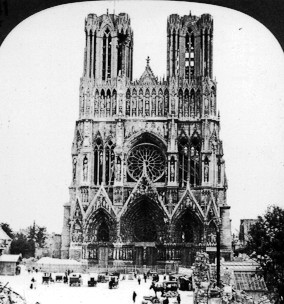Medieval Architects
Today, a great architect ends an era. The University of Houston's College of Engineering presents this series about the machines that make our civilization run, and the people whose ingenuity created them.
Here's something to think about: it was 1960 before any building in London rose as high as the medieval cathedral at Strasbourg. The Strasbourg spire rose forty stories above the town. We made no building that high anywhere until 100 years ago. Only by adding iron and steel could we lift buildings any higher than the Gothic cathedrals.
Down through the 11th, 12th, and 13th centuries, cathedrals became more and more grand. By the mid-1200s they were a technological marvel. And the men who made them knew it.
The 13th century mason-architect was a powerful public figure. Once he'd simply been first among peers. Now he walked with a swagger. In 1258 the maker of Notre-Dame chisled his own name in a 25-foot stone. The next generation of builders were administrators. They no longer touched stone. By 1300 the age of the Gothic cathedral had all but ended.
Let's meet one of the last great medieval builders. He was Villard de Honnecourt. By 1250 Villard had worked on many famous cathedrals. He produced no single masterpiece. But he left behind an astonishing set of sketchbooks.
Those books reflect a dazzling array of interests. He was an innovator. He honeycombed Reims Cathedral with the first set of passageways. They eliminated scaffolding for building, maintenance, and firefighting. His passageways have been part of cathedrals ever since.
Villard's books teem with ideas. Here's a hand-warmer for the bishop to use at high mass. There's the first European sketch of a perpetual-motion machine.
Perpetual motion may seem a poor reflection on Villard. But later he gives that idea another twist. He suggests lasting motion of a workable kind, when he sketches the first clock escapement mechanism. Modern clocks rose out of that crude sketch to change Western thinking and Western science.
Villard traveled to less developed countries. He exported the new architecture. He created intellectual ferment.
Yet by 1300 his kind had grown so grand that they killed their own greatness. They became managers of other people's ideas. They picked the fruit without tending the orchard. By 1300 that glorious era was over.
And we're left to ponder our own errors. For we, too, create a gulf between our imagination and the clear hard stone of making and doing. And we'll pay the same price if we don't find a way to reverse that drift.
I'm John Lienhard, at the University of Houston, where we're interested in the way inventive minds work.
(Theme music)
Gimpel, J., The Medieval Machine. New York: Penguin Books, 1976, Chapter 6.
For more on Gothic Cathedrals, see Episodes 97, 825, and 942. For more on Villard de Honnecourt see Episode 72.

Stereopticon image courtesy of Margaret Culbertson
Reims Cathedral